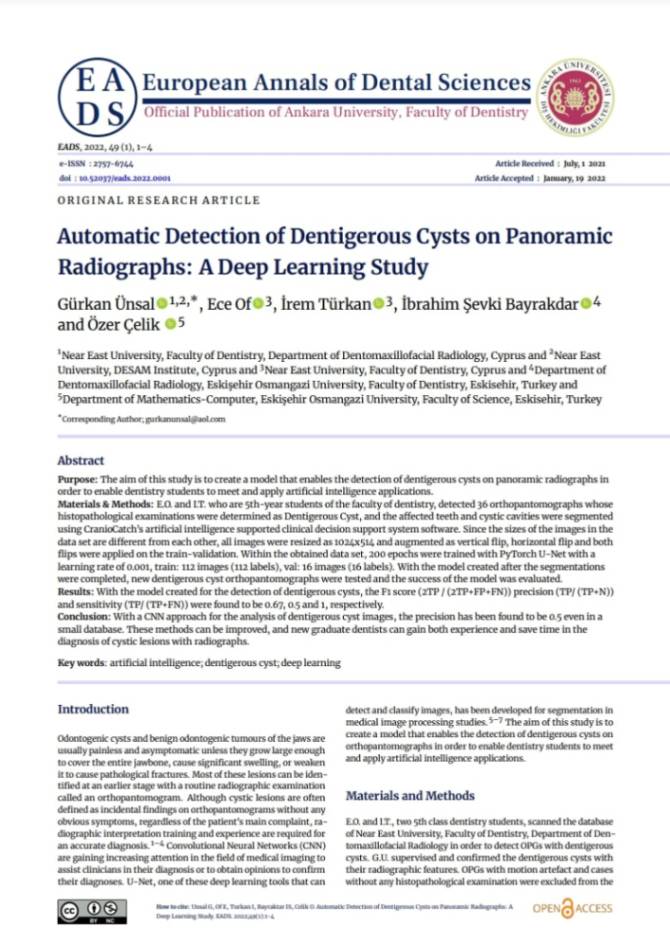An Artificial Intelligence Hypothetical Approach for Masseter Muscle Segmentation on Ultrasonography in Patients With Bruxism
Abstract:
Aim
The study aims to assess the success of an AI system based on the deep convolutional neural network (D-CNN) for segmenting masseter muscles on ultrasonography (USG) images.
Materials and Methods
- Study Design: Retrospective study using 195 anonymized USG images from the radiology archive of the Faculty of Dentistry, Ankara University.
- Technology: Utilized U-net, Pyramid Scene Parsing Network (PSPNet), and Fuzzy Petri Net (FPN) architectures for deep learning.
- Comparison: Manual segmentation and measurements were statistically compared with AI results.
- Statistical Analysis: Accuracy, ROC AUC, and PRC AUC were calculated and compared between human observers and the AI model using the Mann–Whitney U test.
Results
- AI models (FPN, PSPNet, U-net) demonstrated high accuracy in detecting and segmenting masseter muscles.
- The D-CNN measurements were consistent with manual measurements, showing no significant differences.
Conclusion: The AI system is promising for automatic masseter muscle segmentation and thickness measurement on USG images, potentially aiding professionals in diagnosis and saving time.
Introduction
- Bruxism, affecting 8% to 31% of adults, leads to masseter muscle issues such as inflammation and hypertrophy.
- Ultrasonography (USG) is a key diagnostic tool for muscle assessment, but variability in results due to operator experience is a challenge.
- AI and deep learning offer potential improvements in accuracy and efficiency for medical imaging.
Materials and Methods:
Data Collection
- USG images of 24 patients diagnosed with bruxism were collected.
- A total of 195 images were used, divided into training (157), validation (18), and test (20) groups.
Image Annotation
- Manual annotations by an experienced radiologist were used as ground truth.
- AI architectures employed included U-net, PSPNet, and FPN.
Model Training and Evaluation
- AI models were trained to detect and segment masseter muscles.
- Performance metrics such as accuracy, sensitivity, specificity, precision, F1-score, ROC AUC, and PRC AUC were calculated.
Results
- The AI models, particularly FPN and U-net, showed high accuracy (0.985 and 0.969 respectively).
- No significant difference was found between AI and manual measurements (P > .05).
Discussion
- AI systems show potential in improving diagnostic accuracy and efficiency for masseter muscle assessment in bruxism patients.
- The findings align with previous research on AI's effectiveness in medical imaging.
Conclusion
The AI-based approach for USG image analysis is effective for automatic masseter muscle segmentation, aiding in diagnosis and potentially enhancing clinical workflows.
I Want to Write a Scientific Research Project
CranioCatch is a global leader in dental medical technology that improves oral care in the field of dentistry. With AI-supported clinical, educational, and labeling solutions, we provide significant improvements in the diagnosis and treatment of dental diseases using contemporary approaches in advanced machine learning technology.
CranioCatch serves thousands of patients with dental health issues worldwide every day with its innovative technologies. That’s why we eagerly look forward to meeting our valued dentists who wish to work in the field of 'Scientific Research in Dentistry'.



 Contact Us
Contact Us

